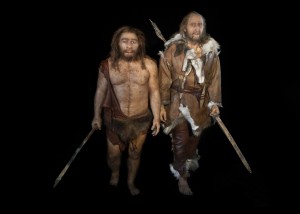Fossil Skull Suggests Neandertals and Modern Humans Interbred
Thursday, January 29th, 2015January 29, 2015.

Prehistoric people stand side by side in this reconstruction based on fossils discovered at sites in Europe. The Neandertal man, left, is a kind of archaic human who lived in Europe and central Asia from about 150,000 to 39,000 years ago. Physically modern humans, above right, only appeared in Europe about 40,000 years ago. The two populations may have mixed and interacted with one another in many ways. Although the Neandertals died out, many humans alive today have small amounts of DNA from Neandertals and other archaic human populations. Reconstruction by Elisabeth Daynes of the Daynes Studio, Paris, France. © S. Plailly and E. Daynes, Science Source
An international team of anthropologists (scientists who study humans and their cultures), led by Israel Hershkovitz of Tel Aviv University in Israel, have published a description of a 55,000-year-old skull discovered in Manot Cave in western Galilee in the journal Nature. The fossil skull has a mixture of features from both Neandertals and modern humans. The scientists claim that the skull provides the first fossil evidence from a critical period in human evolutionary history when early humans migrating out of Africa encountered and interbred with Neandertals.
Neandertals were a physically distinct group of archaic humans who lived in Europe and Central Asia from about 150,000 to 39,000 years ago. Unlike modern people, Neandertals had a long skull, thick skull bones, and a large face with thick browridges. Modern humans differ from archaic humans by the presence of a chin, a vertical forehead, a lack of browridges, and a smaller, less-protruding face compared with Neandertals. Anthropologists believe that physically modern humans originated in Africa and began to migrate into the Levant region (the area around the Mediterranean Sea) and beyond around 60,000 years ago. Fossil evidence shows that Neandertals also lived in the Levant when modern human beings appeared in the region. In the 1980’s, anthropologists found a complete Neandertal skeleton dating to about 60,000 years ago at Kebara, Israel, not far from Manot Cave.
The Manot skull is incomplete, missing the facial portion. However, scientists can tell from the shape of the skull and the thinner bone it is made up of that it is physically modern. Several features of the skull, however, such as a bulge at the back of the cranium (the bones that enclose the brain), called an occipital bun, are characteristic of Neandertal skulls. The scientists claim that the Manot skull demonstrates a “mosaic” of Neandertal and modern traits that likely came about from interbreeding between the two populations. They believe that the Levant may have been an important point where physically modern people moving from Africa met and interbred with Neandertals, who died out after about 35,000 years ago. Such interaction may explain the small percentage of Neandertal DNA that scientists have found persists in human populations living in Europe and Asia today.
Other World Book articles:


